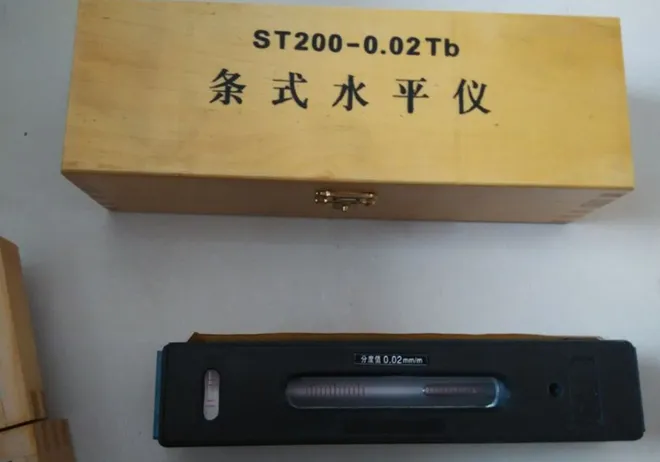Sep . 13, 2024 15:26 Back to list
Frame Levels and Their Applications
Frame levels are essential tools used to check the straightness, horizontal, and vertical positioning of machine tools and equipment. Alongside bar levels, they help ensure precision in industrial settings, such as in machine installations, alignments, and calibration tasks. These tools are typically used in fields like engineering, manufacturing, and construction, where even small inclination errors can lead to significant operational issues.
A frame level is designed with a rigid, rectangular frame, providing a stable base for accurate readings, especially when checking the level of surfaces or equipment over a short distance. Its robust structure makes it ideal for use on machine surfaces and in settings where both horizontal and vertical accuracy are critical.
Common Uses:
- Verifying the straightness and alignment of machinery.
- Ensuring proper horizontal and vertical installation of equipment.
- Checking for small inclination angles in precision work.
The Advantages of a Precision Frame Level
A precision frame level offers higher accuracy compared to standard levels, making it ideal for tasks requiring fine adjustments and precision. These levels are often used in industries such as automotive manufacturing, aerospace, and toolmaking, where precise leveling is essential for ensuring the performance and longevity of equipment.
Key features of a precision frame level include:
- Higher sensitivity: Precision frame levels are typically more sensitive than standard levels, with the ability to detect minute deviations in the horizontal or vertical plane.
- Durable construction: Made from high-quality materials like cast iron or aluminum, precision frame levels are built to withstand industrial environments while maintaining accuracy over time.
- Multiple vials: Precision frame levels often come with multiple vials for checking both horizontal and vertical alignments, providing versatility for various applications.
Applications:
- Calibration of machine tools and industrial equipment.
- Ensuring the accurate setup of CNC machines, lathes, and milling machines.
- Aligning equipment in high-precision manufacturing.

Exploring Level Frames Pricing
The cost of level frames varies depending on several factors, including accuracy, size, material, and brand. For basic frame levels used in general construction or DIY tasks, prices tend to be lower. However, precision frame levels designed for industrial applications, where accuracy is paramount, are often more expensive due to their advanced features and durable construction.
Price factors include:
- Material: Levels made from high-grade cast iron or aluminum are more expensive than those made from lighter materials.
- Precision: Higher accuracy levels, such as those with 0.02mm/m sensitivity, typically cost more.
- Size: Longer or larger frame levels, used for checking larger surfaces, are generally priced higher due to the increased material and production costs.
For industries requiring regular calibration and alignment checks, investing in high-quality precision frame levels is essential for long-term accuracy and reliability, making the higher price worth it.
Pricing Breakdown:
- Standard frame levels: Typically $30–$100.
- Precision frame levels: Range from $100 to $500 or more, depending on sensitivity and brand.
Using a Frame Spirit Level for Machine Tool Setup
A frame spirit level is a specialized type of level that is particularly suited for checking the straightness and alignment of machinery and equipment. It features one or more vials filled with a liquid and an air bubble, which provides an easy-to-read indication of level or alignment. The frame design gives these levels stability, allowing them to rest firmly on machine surfaces.
For tasks such as installing machine tools, adjusting the level of a surface plate, or aligning heavy equipment, a frame spirit level is indispensable. These levels are not only used for checking horizontal or vertical alignment but can also be employed to measure small inclination angles, adding to their versatility in precision environments.
Key Benefits:
- Rigid frame design ensures stability on flat surfaces.
- High accuracy for precise alignment in machinery.
- Easy-to-read vial system for quick and clear level checks.
Frame Level vs. Bar Level: Key Differences
There are two primary types of levels used in industrial applications: frame levels and bar levels. While both serve the purpose of ensuring accurate alignment and level surfaces, they are designed for slightly different tasks.
Frame Level: As described earlier, a frame level is compact and ideal for tasks that require a sturdy base and precise alignment over shorter distances. Its rigid frame makes it suitable for aligning machinery and checking the levelness of equipment in smaller, confined areas.
Bar Level: A bar level is longer and typically used for checking larger surfaces or equipment over a greater distance. Bar levels provide a more extended reference plane, making them perfect for tasks where longer surfaces need to be checked for straightness or levelness, such as in carpentry or long machine beds.
Comparison:
- Frame Level: Compact, highly stable, best for shorter distances and precision tasks.
- Bar Level: Longer, ideal for checking larger surfaces, commonly used in construction.
When it comes to aligning machinery, ensuring the accuracy of installations, or measuring small inclination angles, both frame levels and precision frame levels provide the necessary precision for industrial applications. Whether you’re looking at level frames pricing or selecting the right frame spirit level for a specific task, understanding the advantages of each type can help ensure that your equipment and machines are correctly aligned and operating at peak efficiency.
For industries requiring accurate measurements and high precision, investing in high-quality frame and precision levels is a must. Contact us today to explore our selection of frame levels and bar levels, tailored to meet your specific needs.
-
Thread Plug Gauge Our Promise of Measurement ExcellenceNewsAug.22,2025
-
Gauge Pin Class Reflecting Quality LegacyNewsAug.22,2025
-
Check Valve Types for High Rise BuildingsNewsAug.22,2025
-
Water Control Valve for Irrigation SystemsNewsAug.22,2025
-
Gate Valve with Soft Seal TechnologyNewsAug.22,2025
-
Y Type Strainer for Oil and Gas ApplicationsNewsAug.22,2025
Related PRODUCTS











